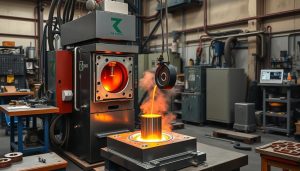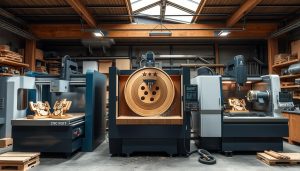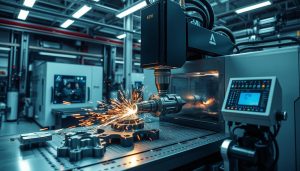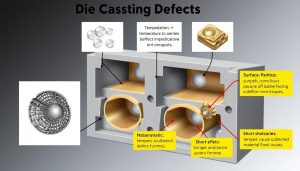Gravity die casting is a versatile metal casting technique that has gained widespread popularity in the manufacturing industry. This process utilizes the power of gravity to fill mold cavities with molten metal, resulting in high-quality, complex parts with exceptional surface finishes. Whether you’re in the automotive, aerospace, or industrial equipment sectors, understanding the gravity die casting process, its benefits, and its diverse applications can be crucial for your manufacturing success.
What is Gravity Die Casting?
Gravity die casting, also known as permanent mold casting, is a popular metal casting method where molten metal is poured into reusable molds using the force of gravity. This process, which is part of the broader category of gravity-fed casting techniques, produces high-quality, precise parts with excellent mechanical properties.
Definition of Gravity Die Casting
Gravity die casting is a metal casting process where molten metal is poured into a reusable mold, or die, under the influence of gravity. The metal is allowed to cool and solidify within the die, forming the desired shape of the cast part. This method is called “permanent mold” casting because the mold is made of metal and can be used repeatedly for multiple castings.
How Gravity Die Casting Works
In gravity die casting, the molten metal is poured into the top of the mold cavity, and gravity pulls the metal down, filling the entire mold cavity. The metal is allowed to cool and solidify within the mold, and the finished part is then ejected. This process is well-suited for producing complex, intricate parts from a variety of metals, including aluminum, brass, copper, magnesium, and zinc alloys.
| Advantages of Gravity Die Casting | Disadvantages of Gravity Die Casting |
|---|---|
|
|
Gravity die casting is a versatile metal casting method that offers a balance of precision, quality, and cost-effectiveness, making it a popular choice for a wide range of applications, from the automotive industry to industrial equipment manufacturing.
The Process of Gravity Die Casting
Gravity die casting is a versatile manufacturing process that involves pouring molten metal into a steel or cast iron mold, allowing the metal to solidify under the force of gravity. This step-by-step process is carefully orchestrated to ensure the production of high-quality, durable cast parts.
Step-by-Step Explanation of the Casting Process
The gravity die casting process begins with the die preparation. The steel or cast iron mold is coated with a specialized lubricant or release agent, ensuring the smooth release of the solidified part. Once the die is ready, the molten metal, such as aluminum, zinc, or copper alloys, is poured into the mold cavity, filling it under the influence of gravity.
The Role of Gravity in the Process
Gravity plays a crucial role in the gravity die casting process. As the molten metal is poured into the mold, it flows and fills the cavity due to the force of gravity, ensuring that the cast part takes on the precise shape and details of the mold. This process allows for the production of complex and intricate parts with high dimensional accuracy and repeatability.
Materials Used in Gravity Die Casting
Gravity die casting is commonly used with a variety of materials, including aluminum, zinc, and copper alloys. These materials are chosen for their specific properties, such as strength, corrosion resistance, and thermal conductivity, which make them well-suited for a wide range of applications, from automotive components to industrial equipment.
| Material | Advantages | Applications |
|---|---|---|
| Aluminum Alloys | Lightweight, corrosion-resistant, high thermal and electrical conductivity | Automotive parts, electronics housings, machinery components |
| Zinc Alloys | High strength-to-weight ratio, good machinability, cost-effective | Automotive accessories, hardware, consumer electronics |
| Copper Alloys | Excellent thermal and electrical conductivity, high strength and durability | Electrical components, heat sinks, industrial equipment |
Benefits of Gravity Die Casting
Gravity die casting offers numerous advantages that make it a preferred choice for manufacturers seeking high-quality, cost-effective production. One of the key benefits is the exceptional dimensional accuracy and surface finish of the cast parts.
High Precision and Quality of Cast Parts
The gravity-based casting process allows for tight control over the filling of the die, resulting in parts with superior dimensional accuracy and consistent surface finish. This precision is crucial for applications where tight tolerances and smooth surfaces are essential, such as in the automotive and aerospace industries.
Cost-Effectiveness for Medium to High Production Runs
Gravity die casting is particularly well-suited for medium to high production runs, as the process is highly automated and efficient. This translates to cost savings for manufacturers, making it a cost-effective solution for producing a large number of parts with consistent mechanical properties and production efficiency.
Durability and Strength of the Final Product
The mechanical properties of gravity die cast parts are exceptional, with high levels of durability and strength. This is due to the controlled filling of the die, which ensures uniform material distribution and minimizes the formation of internal defects. These characteristics make gravity die cast parts well-suited for applications that require robust and reliable components.

“Gravity die casting is a highly versatile and cost-effective manufacturing process that delivers precision-engineered parts with outstanding mechanical properties and surface finish.”
Applications of Gravity Die Casting
Gravity die casting is a versatile manufacturing process that finds extensive use across various industries. From the automotive sector to aerospace and industrial equipment manufacturing, this technique has proven its worth in producing high-quality components and parts.
Automotive Industry
In the automotive industry, gravity die casting is widely employed for creating engine components and structural parts. This process is particularly well-suited for producing engine blocks, cylinder heads, transmission housings, and other critical engine components that require precision, durability, and strength. The gravity-based approach ensures consistent material distribution and reduced porosity, resulting in engine components that can withstand the demanding operating conditions of modern vehicles.
Aerospace and Defense
The aerospace and defense sectors also heavily utilize gravity die casting for the production of aircraft parts. This method is ideal for creating complex, intricate components such as aircraft parts, landing gear, and various engine components. The high dimensional accuracy and structural integrity of gravity die-cast parts are essential for ensuring the safety and reliability of aircraft and military equipment.
Industrial Equipment Manufacturing
Gravity die casting also plays a crucial role in the manufacturing of industrial equipment. This process is commonly used to produce hydraulic valves, industrial machinery parts, and other critical components that require precise tolerances and robust construction. The cost-effective nature of gravity die casting makes it an attractive option for medium to high production runs of industrial machinery parts, ensuring consistent quality and performance.
| Industry | Gravity Die Casting Applications |
|---|---|
| Automotive | Engine components, structural parts |
| Aerospace and Defense | Aircraft parts, landing gear, engine components |
| Industrial Equipment | Hydraulic valves, industrial machinery parts |

“Gravity die casting is an essential manufacturing process for a wide range of industries, enabling the production of high-quality components that are both durable and cost-effective.”
Gravity Die Casting vs Other Casting Methods
When it comes to selecting the right casting technique for a project, understanding the unique advantages of gravity die casting compared to other methods can be crucial. Let’s delve into a comparison with one of the most widely used processes – pressure die casting.
Gravity Die Casting vs Pressure Die Casting
While both gravity die casting and pressure die casting produce high-quality, precise parts, there are distinct differences that make each method better suited for specific applications. Pressure die casting typically excels at producing smaller, more intricate components with tight tolerances, owing to the high pressure used to force molten metal into the mold. Gravity die casting, on the other hand, is better suited for larger, less complex parts that require greater strength and durability.
| Feature | Gravity Die Casting | Pressure Die Casting |
|---|---|---|
| Part Size | Larger parts | Smaller, more intricate parts |
| Tolerance | Wider tolerances | Tighter tolerances |
| Strength and Durability | Greater strength and durability | Moderate strength and durability |
| Production Volume | Suitable for medium to high production runs | Ideal for high-volume production |
Why Choose Gravity Die Casting?
Gravity die casting shines when the project requirements call for larger, more robust parts with excellent mechanical properties. Automotive components, industrial equipment, and aerospace parts are all prime examples of applications where gravity die casting excels. The process is also cost-effective for medium to high production runs, making it a viable option for manufacturers seeking a balance between quality, efficiency, and cost-effectiveness.
“Gravity die casting is a versatile and reliable process that delivers exceptional results for a wide range of industries and applications.”
Shixinproto provides die casting services for complex and high-volume projects
At Shixinproto, we pride ourselves on our exceptional die casting services, catering to the needs of clients with complex and high-volume production requirements. Our state-of-the-art facilities and skilled team of professionals are dedicated to delivering exceptional quality and precision, ensuring your projects are completed to the highest standards.
With a deep understanding of the gravity die casting process, Shixinproto has garnered a reputation as a trusted partner for various industries, including automotive, aerospace, and industrial equipment manufacturing. We leverage our expertise to produce intricate parts that meet your exact specifications, consistently delivering reliable and durable solutions.
Whether you require complex components or need to scale up your production, Shixinproto is equipped to handle your project with ease. Our commitment to customer satisfaction and our unwavering focus on meeting industry standards make us the go-to choice for discerning clients seeking exceptional die casting services.





